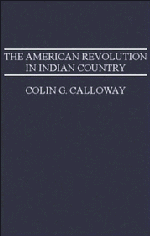Book contents
- Frontmatter
- Dedication
- Contents
- List of figures and maps
- Preface
- Acknowledgments
- Abbreviations
- Prologue New worlds for all: Indian America by 1775
- 1 Corn wars and civil wars: the American Revolution comes to Indian country
- 2 Odanak: Abenaki ambiguity in the North
- 3 Stockbridge: the New England patriots
- 4 Oquaga: dissension and destruction on the Susquehanna
- 5 Fort Niagara: the politics of hunger in a refugee community
- 6 Maquachake: the perils of neutrality in the Ohio country
- 7 Chota: Cherokee beloved town in a world at war
- 8 Tchoukafala: the continuing Chickasaw struggle for independence
- 9 Cuscowilla: Seminole loyalism and Seminole genesis
- 10 The peace that brought no peace
- Epilogue A world without Indians?
- Index
9 - Cuscowilla: Seminole loyalism and Seminole genesis
Published online by Cambridge University Press: 18 December 2014
- Frontmatter
- Dedication
- Contents
- List of figures and maps
- Preface
- Acknowledgments
- Abbreviations
- Prologue New worlds for all: Indian America by 1775
- 1 Corn wars and civil wars: the American Revolution comes to Indian country
- 2 Odanak: Abenaki ambiguity in the North
- 3 Stockbridge: the New England patriots
- 4 Oquaga: dissension and destruction on the Susquehanna
- 5 Fort Niagara: the politics of hunger in a refugee community
- 6 Maquachake: the perils of neutrality in the Ohio country
- 7 Chota: Cherokee beloved town in a world at war
- 8 Tchoukafala: the continuing Chickasaw struggle for independence
- 9 Cuscowilla: Seminole loyalism and Seminole genesis
- 10 The peace that brought no peace
- Epilogue A world without Indians?
- Index
Summary
By the end of the American Revolution many Indian villages – in Iroquoia, the Ohio Valley, the Smoky Mountains, and elsewhere – lay in ruins. Their inhabitants were dead, huddled in refugee camps, or had fled to new homes beyond the reach of American expeditions. Survivors faced a harrowing future in the new nation. The winning of American independence meant destruction and dependence for many Indian people. But the revolutionary era witnessed community creation as well as community destruction. Refugees rebuilt war-torn lives and constructed new towns, often amalgamating in one community the dispersed survivors of several villages. Warriors from different tribes joined forces in towns that the Americans described as “renegade strongholds.” And some Native American communities were developing their own independence and asserting a separate identity.
The Seminole Indians did not figure prominently in the Revolutionary War; indeed the standard book on southern Indians in the Revolution barely mentions them. Nevertheless, Seminoles did play a role in the war, and the Revolution did have an impact in Seminole country. Florida was one of the British provinces that did not seek independence from George III during the Revolution. Its fate at the war's end was not independence but continuing colonial status with a return to Spanish dominion. However, the changing colors on the political map of East Florida as one European monarch handed the province to another did not reflect the continuing loyalism to Britain of many of the Seminole Indian inhabitants. Moreover, it obscured political changes at the tribal level, as the people who actually controlled most of Florida took tentative steps away from their “mother country” and toward some nation building of their own.
The Seminole Indians did not exist before 1700, and the groups that composed the Seminoles did not coalesce into a unified polity until well after the American Revolution. In the early sixteenth century several hundred thousand Indians lived in Florida.
- Type
- Chapter
- Information
- The American Revolution in Indian CountryCrisis and Diversity in Native American Communities, pp. 244 - 271Publisher: Cambridge University PressPrint publication year: 1995



